The design of the ceiling space today is given special attention. And this is no accident: a beautiful ceiling significantly raises the status of the interior. It is especially important that he be beautiful in the living room - the place where households and their guests gather. In the article we will consider varieties of plasterboard ceilings, note the nuances of choosing the optimal design and the features of choosing an option for a particular interior stylistics.


Advantages and disadvantages
Drywall is a building material sheet format lightweight type. It is based on lightweight gypsum, equipped with special additives. Due to this feature, drywall has the flexibility that allows it to take the necessary shape. On both sides, the gypsum is framed in special construction paper, while the ceiling sheets are thinner than the wall ones.
These systems can beat the disadvantages of the perspective of a particular hall, giving them the appearance of design features. For example, in a living room it can be a decoration divided into several zones with different heights and shapes.
Sometimes the design provides for the transition of the sheet to the wall, which looks invisible and fresh.
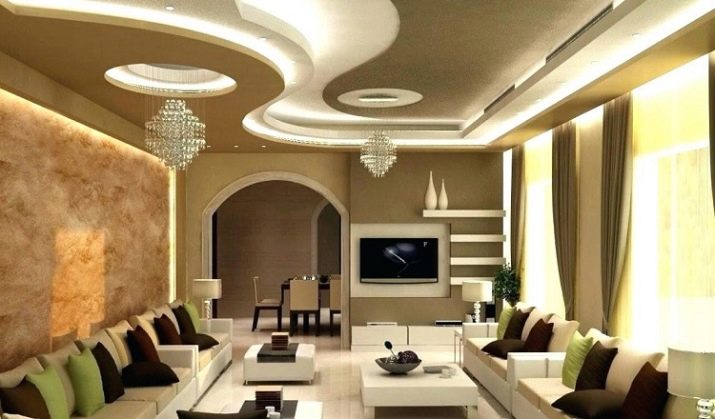





In addition, ceilings from this material have many other advantages.
- They are characterized by optimal weight, so they do not create a large weight load on the walls and ceiling. This allows you to create not only simple, but also complex design solutions.
- The sheets may vary in size, but during operation they are not deformed or sagged.They are perfectly attached to the frame and do not bend after they are given the desired shape.
- The material allows for different technologies for installing ceiling structures. Today it can be built on a metal and wooden frame, and in some cases glued to a prepared base.
- Drywall has excellent technical and operational characteristics. It is durable, fireproof and moisture resistant, has noise insulation properties, which is especially important for residents of apartment buildings.
- Plasterboard ceilings look aesthetically pleasing. Their design can be concise and complex, indicating that they belong to a certain interior style.
- The material goes well with other types of ceiling materials (battens, film, panels). This allows you to diversify the design of the ceiling space, to make it unique.
- In most cases, when installing plasterboard ceilings, it is not necessary to prepare the base. This significantly saves installation and installation time.
- It is not difficult to work with drywall: such ceilings can be installed independently, without involving external specialists. It will not take much time to master the technology.
- Drywall ceiling structures are not limited in color schemes, the material can be painted in any shade that the customer likes.
- Drywall is undemanding to the installation of fixtures. You can decorate such a ceiling with a wide variety of lighting devices. It is not difficult to mount chandeliers and spotlights in it, it is not fused.
- Plasterboard ceilings are often tools for design zoning of space. This is especially convenient for organizing a living room, brings order to it.
- The material can be decorated not only with internal and hidden lighting, but also with moldings, stucco molding, painting, baguette. Its installation allows you to hide the unevenness of the walls in height.
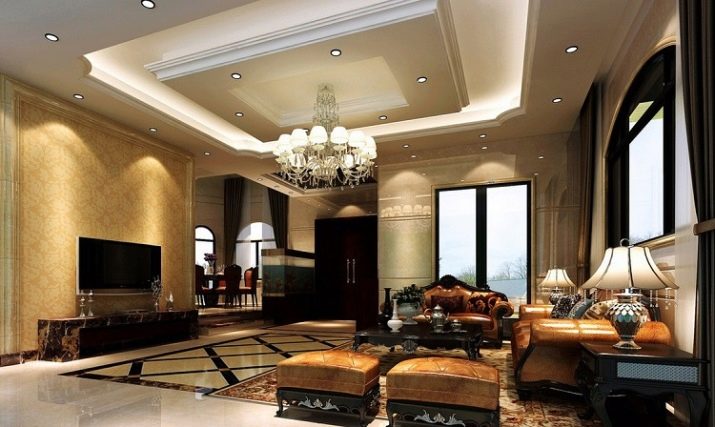
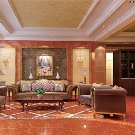




In addition to the advantages, plasterboard ceilings for the design of the living room or hall have several disadvantages.
- Frame systems reduce the height of the walls, which is bad for installation of structures in small-sized apartments with low ceilings (less than 2.5 m).
- Simple systems are simple to make, for complex design decisions you will have to use the services of a specialist.
- The material is malleable, but with incorrect and inaccurate design calculations it can crack or bend.
- Excessively deep fastening of the clamps can lead to their drowning in sheets, which affects the aesthetics of the design.
It is undesirable to use a wood frame, as the wood can become deformed over time.






Types of structures
Euro drywall ceilings may be different. Conventionally, they can be classified by the number of levels. Based on this, they are:
- single-level;
- two-level;
- three-level;
- multi-level.
Sibling options are considered the simplest. In fact, these are sheets of drywall stitched together, comprising together a single piece of canvas. Two-level differ in the design of the so-called two steps. In addition, the second levels may be figures attached to the first. Three-level and multi-level perform, forming a larger number of frame steps. In this case, installation begins from the lower tiers.



The manner of execution of the designs of plasterboard ceilings in the living room can also vary. Design options are linear, frame and curly. According to the visual effect, the design can be zonal or soaring. Zonal means design with an emphasis on a small portion of the ceiling. Soaring analogues have an unusual effect, in which it seems that the ceiling is hanging in the air.
False ceilings are called because of the technology of fastening, in which they use suspensions. Floating structures are distinguished by the ability to rotate. As a rule, these are accents of a small size, the shape of which can be square, rectangular or round. Often, these systems are supplemented by their own built-in backlight.
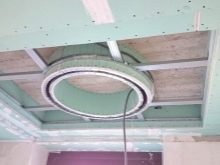
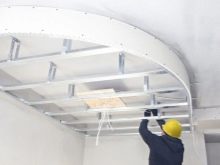

Linear modifications are standard solutions using straight lines and shapes in the design. Framework analogues differ in appearance. In fact, this is a box, inside which a material contrasting in color or texture is inserted. For example, it can be the so-called combined design techniques, where drywall is supplemented with a stretch film.
Figured ceilings imply the use of wave-like, curved lines and cut-out shapes in the design without a craving for geometricity. Figured ceiling lines can be zigzag or consist of a combination of smooth contours with huge figures cut from sheet ceiling gypsum plasterboard.



Color spectrum
The colors of plasterboard ceilings can be very diverse. However, in the living room, it is necessary to take into account the color ability of creating the atmosphere of the hearth to a greater extent. For this reason, it is customary to avoid the abundance of dark colors and negative color combinations in living rooms. It is scientifically proven that dark tones bring some discomfort to the interior of any home.
The best tones for ceiling decoration are considered white color and light colors of pastel colors. The relevance of white is explained by its ability to accept the emotional coloring of the color with which it is combined. It is universal and suitable as a softener even for the dynamic color of the interior, chosen as the basis for the arrangement of the living room.
White color visually increases the height of the walls, erases the rigid boundaries of the room, saturates the room with light and air.






Black is appropriate as a small expressive touch. There should not be much of it in the color scheme of the ceiling space, like poisonous red or sharply orange. To create a place with a welcoming and positive atmosphere in the interior of a guest room, you can select design options in light and muted colors. They look noble, do not attract all the attention, but at the same time significantly increase the status of the interior.



Ideal tones when choosing a color can be beige, milky, creamy, ivory and bleached peach. Warm shades are appropriate in a room whose windows face north. Cool tones are more suitable for the southern living room. The ceiling of light-colored coffee with milk and a shade of cocoa looks beautiful in the interior of the hall.



Blue, violet tones are considered complex, when choosing them, you will have to pay a lot of attention to the selection of “softeners” so that the interior composition does not seem gloomy. The ceiling should not visually put pressure on households or guests. If you choose dark tones, then they must be diluted with light contrasts.



If the owners want something interesting, you can choose option in white and complement it with a hidden RGB LED strip. Depending on what tone of the light flux households choose, the ceiling will change its color.



Style solutions
The style of the interior of the home is the key criterion that often suggests the type of ceiling design design. In the living room, like any other room in an apartment or a private house, the style can be very diverse. To understand how to choose the right option and not make a mistake, you need to build on the resources of a particular area of interior design.
For instance, classic style brancheswhich include classic, neoclassic, classicismneed deliberate elegance. It is important to point out the high cost, high status, a certain palace solemnity. They embody such decisions in large-area living rooms, since pomposity is simply inappropriate in a limited space.
This is necessarily symmetry in the design, the apparent severity of the lines, the combination of drywall with tension film, the use of light shades of the color palette.



Design should not be concise: everything should indicate that respectable people live in the dwelling. Mandatory design attribute should be massive chandelier. The decoration can be frame, with decoration of each corner of the drywall box with gilding or moldings. The use of stucco decoration is encouraged, but the combination with photo printing on film is undesirable in this case: manufacturability is not a sure sign of a classic interior.
Modern branches of design, on the contrary, are literally permeated with the atmosphere of modernity. Such a design should seem simple, but in reality be smart. However, the elegance of, say, styles minimalism, modern, art deco, brutalism differs from the classics. Here should not give away a certain bourgeoisie.
It is important that the design was simple, but "tasteful."



For example, it may be the contrast of neutral colors, which today is considered one of the fashionable decisions in choosing a ceiling design. For styles that adhere to minimalism, it is important to remove everything superfluous from the design, because you can decorate it with the same functional lights. This is more than enough in a space to which everything pompous is alien (for example, to minimalism).
The Art Nouveau ceiling design as opposed to the straightforward and rustic minimalism cannot be single-level. Here, curly and soft forms are welcomed, the mandatory use of built-in and often hidden highlights (including inside the film when combining it with drywall).
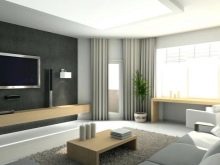
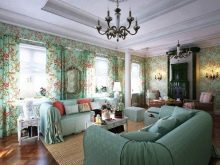

Design options
The modern approach to the design of plasterboard ceilings can vary greatly. Each new season, interior designers offer a lot of stylistic design novelties. For example, you can decorate the ceiling with various patterns, if this does not contradict the trends of a particular style. And also it can be, for example, a picture drawn with the help of special paints in the theme of interior styling. In some cases, it can go to the accent part of the wall for a specific functional area of the living room.
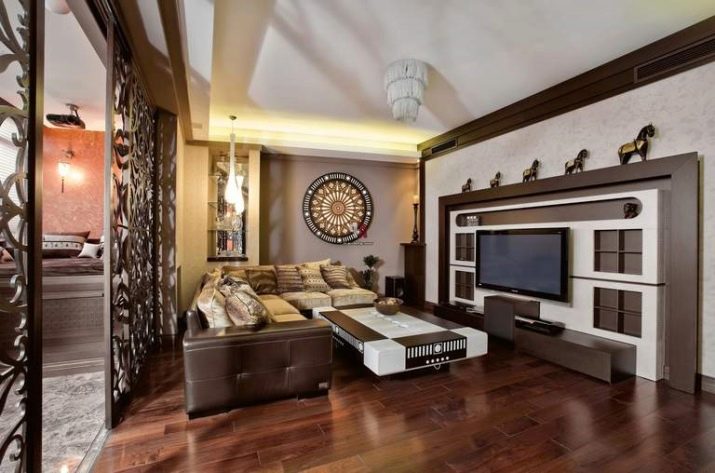




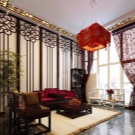
Besides, it is possible to orient the design to emphasize a figure. Say, curved lines, circles marked with LED strip look good on the ceiling. Often in 2-level designs, it is the tape that creates a unique design, marking the boundaries of one of the levels and drawing more attention to the central lighting device. It goes well with panels (wall lights), spots and spot lights.
The design can be a frame ceiling with the addition of a geometric or fantasy figure on one side of the box. Wherein in most cases, such figures are emphasized by point lighting devices and tape.
Abstract patterns are also possible from elements of a ceiling composition cut out in a concrete form.






As for the emphasis on small figures in the design of drywall constructions, then design can be both concise and complex (using soaring mounted systems). Someone highlights the chandelier, creating ornate and abstract shapes, others cut petals from drywall, accentuating the chandelier with their help. Often the emphasis is on the use of a stretch film.
At the same time, the ceiling can be elegantly selected by choosing the contrasting color of the film material or by photo printing, texture, embedding optical fiber and LED strip inside the film. The effect of such ceilings is amazing: they seem voluminous and are able to give high status to any interior.However, everything can be spoiled by the choice of drawing: neither huge flowers, nor soaring giant pigeons will create a comfortable atmosphere in the hall.
However, stylized ornaments at the edges of the film will be quite appropriate, as well as the starry sky created using optical fiber.

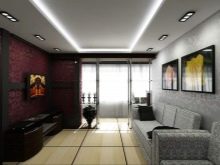

How to choose?
To choose the best option for decorating a plasterboard ceiling, it is worth considering several nuances.
- For a living room of a small area, a design option is selected without unnecessary decoration. You must follow the rule "smaller room - simpler design."
- For a room in an apartment with a high ceiling, you can choose a two-level or three-level type of ceiling. If the room is large, one of the areas of the living room can be identified by a special figure.
- The backlight is selected based on stylistic resources. If classics need chandeliers and candelabra, in a modern design it is more appropriate to spot, spot, panel lamps and tape.
- The type of room is important: for a square ceiling, zonal division is necessary to create a visual lengthening effect. A narrow rectangular should be diluted with decor on the sides, getting rid of the effect of visual imbalance.
- In a house with a two-level living room, the design can be complex multi-level. This will not affect the height of the ceiling so noticeably.
- The color of the material should not be dark, as gloomy shades visually steal the height of the walls. In addition, darkness at a subconscious level puts pressure on households.
- The footage of the hall matters: 16 and 18 square meters. m allow you to create a design where only one emphasis is used. At the same time, it is better to avoid visual underlining of the entire ceiling canvas.
- If you plan to put the furniture against the wall, emphasis can be placed on this area. For example, it can be a design in the form of a semicircle, supplemented by spotlights.
- If you want to designate a TV zone, you can create a backlit figure by placing it on the wall on the sides of the video zone. Shapes of a figure can be different.
- With a studio layout, it is worth highlighting the ceiling above the guest area. At the same time, other functional islands need to be supplemented with their own backlight devices.
- The backlight, in addition to the style solution, is selected taking into account the installation capabilities. Embedding optical fiber and LED strip under the stretch film in a plasterboard box or figure can only be done by a professional.
- Drawings and patterns are appropriate where there is room, and in a limited space large figures and patterns do not look attractive. Stucco molding is not used in minimalist styles.
- When choosing a design with a drawing on a stretch film, the texture is also important: the gloss during illumination gives glare, as a result of which part of the picture will not be noticeable when the light is on.


Beautiful ideas
Nothing will explain the design possibilities of plasterboard ceilings better than illustrative examples.
- Drywall ceiling decoration for a large room.

- Ceiling accent of the lounge area.

- Ceiling with a stretch film in a contrasting color.

- An option for decorating the ceiling in a bright living room.

- Zone design using LED strip.

- The design of the ceiling area with soft lines.

- Accentuation of the central lamp in the interior of the living room.

- Ceiling design with illuminated guest space.

- The choice of design for a room with a TV area.

- Using interior lighting to accent the ceiling.

For how to make a gypsum board ceiling with round sides with your own hands, see the next video.










